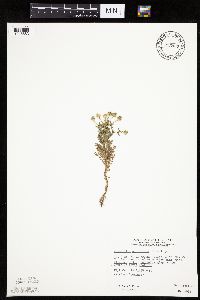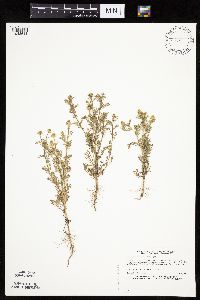Matricaria discoidea
|
|
|
|
Family: Asteraceae
Pineapple-Weed, more...disc mayweed, pineapple weed, pineappleweed
[Artemisia matricarioides auct. non Less., moreChamomilla suaveolens (Pursh) Rydb., Lepidanthus suaveolens (Pursh) Nutt., Lepidotheca suaveolens (Pursh) Nutt., Matricaria matricarioides auct. non (Less.) Porter, Santolina suaveolens Pursh, Tanacetum suaveolens (Pursh) Hook.] |
Annuals, (1-)4-40(-50) cm; aromatic (pineapple odor when bruised). Stems 1-10+, usually erect or ascending, sometimes decumbent, branched from bases. Leaf blades (5-)10-65(-85) × 2-20 mm. Heads discoid, (1-)4-50(-300), usually borne singly, sometimes in open, corymbiform arrays. Peduncles 2-25(-30) mm (sometimes villous near heads). Involucres 2.5-3.8 mm. Phyllaries 29-47+ in 3 series, margins mostly entire. Receptacles 2.5-7.5 mm, ± acute or obtuse. Ray florets 0. Discs hemispheric to broadly ovoid, 4-7(-11) × 4-7.5(-10) mm. Disc florets 125-535+; corollas greenish yellow, 1.1-1.3 mm (± glandular), lobes 4(-5). Cypselae pale brown to tan, ± cylindric-obconic (asymmetric, abaxially ± gibbous distally), 1.15-1.5 mm, ribs white (lateral 2 each with reddish brown mucilage gland along ± entire length, glands sometimes distally expanded, abaxial 1-2 weak, sometimes each with elongate mucilaginous gland), faces not glandular; pappi coroniform, entire. 2n = 18. [as M. matricarioides] Flowering early summer-fall. Open areas, bare disturbed areas and rural or urban waste grounds, sometimes alkaline, roadsides, railroads, footpaths, cultivated and abandoned fields and gardens, irrigation ditches, stream banks, sandbars; 0-2700 m; Greenland; St. Pierre and Miquelon; Alta., B.C., Man., N.B., Nfld. and Labr., N.W.T., N.S., Ont., P.E.I., Que., Sask., Yukon; Alaska, Ariz., Ark., Calif., Colo., Conn., Del., Idaho, Ill., Ind., Iowa, Kansas, Ky., La., Maine, Md., Mass., Mich., Minn., Miss., Mo., Mont., Nev., N.H., N.J., N.Mex., N.Y., N.C., N.Dak., Ohio, Okla., Oreg., Pa., R.I., S.C., S.Dak., Tenn., Tex., Utah, Vt., Va., Wash., W.Va., Wis., Wyo.; introduced in Eurasia, Australia. Matricaria discoidea has been used as a medicinal and aromatic plant by Native American tribes (D. E. Moerman 1998). It also is considered a weed, and it is resistant to a photosystem II inhibitor herbicide in the United Kingdom (www.weedscience.org). It is a northwestern North American native that has spread to eastern and northern North America and elsewhere (E. McClintock 1993b; E. G. Voss 1972-1996, vol. 3; A. Cronquist 1994). NatureServe (www.natureserve.org) and Natural Resources Conservation Service (plants.usda.gov) erroneously present M. discoidea as introduced on the continent. Its natural habitat is ill-defined because the species has become ruderal even in its native range. For discussion of the nomenclature of this taxon, see S. Rauschert (1974); K. N. Gandhi and R. D. Thomas (1991); Cronquist; and Voss. Matricaria matricarioides (Lessing) Porter cannot be applied to the American taxon; M. matricarioides was originally published as Artemisia matricarioides Lessing, a new name for Tanacetum pauciflorum Richardson (see S. Rauschert 1974), itself a synonym of T. huronense Nuttall. W. Greuter (pers. comm.), who accepts M. discodea, considers Rauschert´s treating Artemisia matricarioides as homotypic with T. pauciflorum as equivalent to a lectotype designation.
Branching, leafy, pineapple-scented, glabrous annual 5-40 cm; lvs 1-5 cm, 1-3 times pinnatifid, the ultimate segments short, linear or filiform; heads several or many, rayless, the disk 5-9 mm wide; invol bracts with broad hyaline margins; disk- cors 4-toothed; receptacle conic, pointed; achenes with 2 marginal and one or sometimes more rather weak ventral nerves; pappus a short crown; 2n=18. Roadsides and waste places; cordilleran region, intr. e. to the Atlantic. May-Sept. (M. discoidea; M. suaveolens (Pursh) Buchenau, not L.; Chamomilla s.) Gleason, Henry A. & Cronquist, Arthur J. 1991. Manual of vascular plants of northeastern United States and adjacent Canada. lxxv + 910 pp. ©The New York Botanical Garden. All rights reserved. Used by permission. From Flora of Indiana (1940) by Charles C. Deam This species has been reported from only three counties yet I believe it may be found throughout the state. The decumbent habit of the plant and its rayless heads have, I believe, led collectors to pass it by, thinking that such specimens were trampled down or non-flowering specimens of Anthemis cotula. I know that I so regarded the species for many years until I discovered my error. All of my specimens are from barnyards except one which is from a roadside. .…… Indiana Coefficient of Conservatism: C = null, non-native Wetland Indicator Status: FACU |
|
|
|


























































































